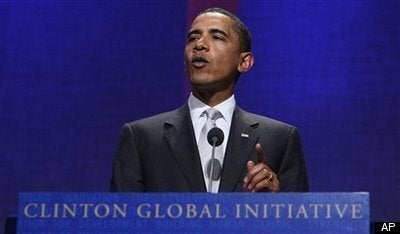
By Jonathan Granoff and Rhianna Tyson Kreger
President Obama's historic Security Council summit on nuclear disarmament and nonproliferation should be seen for what it is: an extremely important step towards a safer, saner, more secure planet.
The September 24th summit resulted in the adoption of a resolution that reaffirms already existing agreements, such as the importance of the nuclear Non-Proliferation Treaty. While boring to the general public and disappointing to arms control wonks -- overly eager for bigger and bolder actions -- this Security Council meeting nonetheless reestablishes forward movement after years of backsliding on disarmament and non-proliferation commitments.
More than hailing the importance of the NPT and other existing commitments, the resolution gives impetus to achieving other important agreements. The treaty prohibiting all nuclear test explosions, for instance, received a significant boost, not only by the adoption of resolution 1887 but also by the presence of Secretary Clinton, just down the hall, the first senior official to represent the US at the annual conference focused on securing that treaty's existence. The resolution also pushes governments to negotiate a new treaty to prohibit, worldwide, the production of fissile materials for weapons purposes.
No Security Council resolution can eliminate nuclear weapons and nor should any responsible leader try to eliminate nukes by any one fell swoop. The abolition of nuclear weapons is a process, not an occurrence. It is gradual and understated, like the President's own sophisticated strategy towards achieving a nuclear weapon-free world, of which a Security Council resolution, adopted at the highest levels of state, is just one small, important step.
These agreements achieve more than just arms control measures. This network of treaties and the scores of UN resolutions that affirm their importance constitutes a web of relationships -- between governments, between human beings -- that engenders the cooperation necessary to address all of our global challenges. Agreements like the Comprehensive Test Ban Treaty have created physical, tangible infrastructure that is required to ensure compliance with the agreement. Components of the International Monitoring System are scattered all over the globe, giving all nations holistic, networked tools that inform us, not just with data on nuclear explosions, but on earthquakes, tsunamis and other natural disasters possibly made more frequent by the collective challenge of climate change.
This social architecture of relationships and infrastructure reflects the interconnectedness of our security in the 21st century. Investment in this web creates the political environment that is needed to move further down the road to nuclear abolition and a more secure planet. And as our global tools grow in strength and scope, as the alphabet soup of treaties and resolutions thickens, so do our relationships, between governments and amongst peoples, ensuring the security for all humankind.
